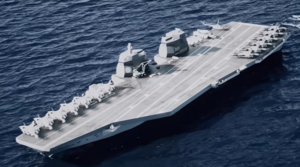Gwanaksan Class Aircraft Carrier
 KCVN-18 KHMS Hallasan is sailing in the East Sea.
| |
| Class overview | |
|---|---|
| Builders: | Hyundai Heavy Industries Co.,Ltd. |
| Operators: |
|
| Preceded by: | Baekdusan-class |
| Cost: | 13.2 billion NSD $ |
| Built: | 2005-2020 |
| In service: | 2008-present |
| Planned: | 8 |
| Building: | 0 |
| Completed: | 6 |
| Cancelled: | 2 |
| Active: | 6 |
| General characteristics | |
| Class and type: | Aircraft carrier |
| Displacement: | 100,200 tons, full load |
| Length: | 335 m |
| Beam: | 79 m |
| Draft: | 15 m |
| Propulsion: |
|
| Speed: | 30 knots(Maximum speed) |
| Range: | Unlimited / 250 days for one-time supply |
| Complement: | 1,115(Crews)+2,215(Airwing) |
| Sensors and processing systems: | 4 X S-Band AESA Radars |
| Armament: |
|
| Armour: | Classified |
| Aircraft carried: | 96 fixed wings and helicopters |
The Gwanaksan Class Aircraft Carriers are a type of nuclear-powered aircraft carrier operated by the Royal Joseon Navy. The Gwanaksan Class carriers are the heaviest warships built in Joseon, and following tradition, the ship's name comes from the name of Joseon's mountains.
The Gwanaksan class carriers were designed to replace the Baekdusan class carriers, the conventional propulsion aircraft carriers used by the Royal Joseon Navy, and to respond to the naval buildup plans of neighboring countries. The original plan was to build 12 aircraft carriers, but the plan was reduced to 9 in the final stages of the decision.
The Gwanaksan class carriers are not the only supercarriers in service with the Royal Joseon Navy, but as a single type of aircraft carrier, the largest number of ships are operated in the Royal Joseon Navy.
In 2024, the Joseon government began a feasibility research of the Gwanaksan class Batch-2, a performance-improved version of the Gwanaksan class.
Description
Design
The Gwanaksan class carriers adopted the twin island structure, which was an innovative structure at the time of development. The aircraft carrier has two islands(Bridges), the forward island is responsible for ship-related functions such as navigation and radar operations, and the rear island is responsible for air operations. If necessary, each island may even be responsible for the functions of another island.
The Gwanaksan class carriers use four steam catapults to take off an aircraft. Theoretically, 12 aircraft can take off per minute, but this is on the premise that the carrier is in optimal condition. When aircraft are landing on an aircraft carrier, the four arresting wires brake the aircraft and land it on the deck.
Defense capability
The Gwanaksan class aircraft carrier maintains the ship's anti-aircraft defense capabilities by installing two AESA radars each on the front bridge and rear bridge. The 4 S-Band AESA radars are linked to air defense missiles equipped on 16-cell VLS and are responsible for the ship's final defense. Typically, a ship's VLS is equipped with ESSM missiles or K-SAAM Haegung-1 missiles, which can accommodate 4 missiles per cell.
Air operational capability
Generally, the Air Wings of The Gwanaksan class aircraft carrier are configured as follows.
- 2 Strike fighter squadrons (24 Aircraft. KF-24 Huinmae or F/A-38A Sentinel or F-35C)
- 2 Air superiority fighter squadron (24 Aircraft. KF-23 Chammae or F-40A Whirlwind)
- 1 Electronic warfare squadron (8 Aircraft. EA-18G)
- 1 Airborne early warning squadron (4 Aircraft. E-2D or A 17 Sentinel)
- 1 Anti-Submarine warfare squadron (4 Aircraft. S 5 Corsair)
- 1 Anti-Submarine warfare helicopter squadron (8 Helicopters. NUH-1)
In a war situation, Air wings are organized as follows.
- 3-4 Strike fighter squadrons (36-48 Aircraft. KF-24 Huinmae or F/A-38A Sentinel or F-35C)
- 2 Air superiority fighter squadron (24 Aircraft. KF-23 Chammae or F-40A Whirlwind)
- 1 Electronic warfare squadron (8 Aircraft. EA-18G)
- 1 Airborne early warning squadron (4 Aircraft. E-2D or A 17 Sentinel)
- 1 Anti-Submarine warfare squadron (4 Aircraft. S 5 Corsair)
- 1 Anti-Submarine warfare helicopter squadron (8 Helicopters. NUH-1)
List of ships
- KHMS Gwanaksan (CVN-012)
- KHMS Jirisan (CVN-015)
- KHMS Palgongsan (CVN-016)
- KHMS Bukhansan (CVN-017)
- KHMS Hallasan (CVN-018)
- KHMS Dobongsan (CVN-019)